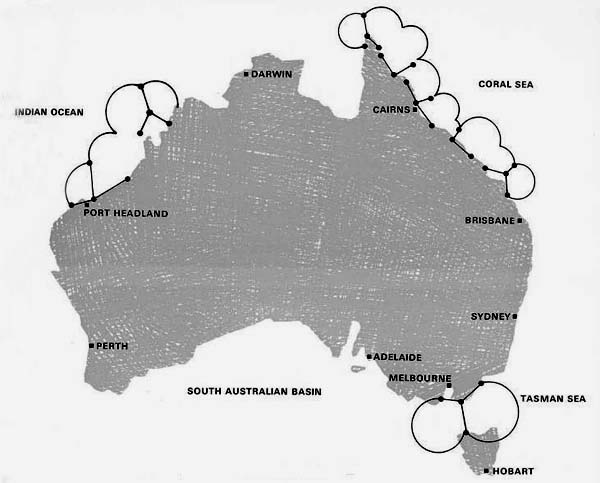 |
| This chain proposal was prepared for discussion purposes only and did not represent any finalized scheme. Only two chains would be built. (From Decca Navigator News June 1968) |
A DECCA PLAN FOR AUSTRALIA
From Decca Navigator News, June 1968A Symposium dealing with all aspects of the Decca Navigator System was held at the Menzies Hotel, Sydney between 26th and 29th March 1968. The sponsors were Amalgamated Wireless (Australia) Ltd, Amalgamated Decca Surveys Pty Ltd and The Decca Navigator Company Limited, London.
The main purpose of the Symposium was to present to the Department of Shipping and Transportation and to Australian shipping and air interests, a plan for the Decca System in Australia. It had been decided to hold the Symposium in Australia following the Minister's statement that the Australian Government intended to initiate a detailed study of the requirement for a higher category electronic navigation aid.
The requirement for a navigational aid for marine use arose as, with ever increasing production of minerals in Australia, new shipping routes are being used and large, deep draught vessels are proceeding through areas where navigational aids are insufficient. In particular, the areas off the coast of NW Australia and the Barrier Reef as well as the waters of the Bass and Torres Straits. The Decca System, being a standard international radio navigational aid for marine purposes, was particularly suited as the aid to meet these requirements.
The Symposium was opened by the Australian Minister for the Navy, the Right Honourable Charles Kelly who spoke of the Commonwealth plan for a 15 million dollar programme for updating and extending navigational aids and said that, although international discussions were taking place, Australia, because of her urgent requirements, could not wait for these decisions.
Mr. Gerald Unkles of the Department of Shipping and Transport, opened the second day of the Symposium and explained his Department's interest. Following his remarks, a possible plan for Decca coverage over the areas concerned was displayed and considerable interest was shown by the Government departments and shipping interests present. Special presentations were given dealing with air applications of Decca Navigator and aviation authorities were shown a film illustrating the new Omnitrac operating under a variety of conditions.
The second half of the Symposium was opened by Captain Cooper, a Australian Hydrographer who was involved with Decca Survey in Australia and other parts of the world. New, high speed data acquisition systems and the punch tape typewriter readout caught the interest of the survey authorities whilst Sea-Fix equipment, the Krupp Atlas Echo Sounder and a model of the Decca/Hovermarine Surveymarine craft attracted much attention.
The Australian broadcasting and television companies and the national press reported the progress of the Symposium and photographs and films of demonstrations of Hi-Fix in Sydney Harbour were widely featured. Detailed press reporting of the various speeches was made and stress was placed on the Minister's statement that the risks were too great for Australia to sit back and wait for others to make decisions.
 |
| This chain proposal was prepared for discussion purposes only and did not represent any finalized scheme. Only two chains would be built. (From Decca Navigator News June 1968) |
 |
| Most of the stations in the Port Hedland and Dampier chains are shown in their approximate positions due to the difficulty of locating detailed maps. Port Walcott, also referenced in the text, is approximately half way between Dampier and Port Hedland. (Graphic courtesy Multimap) |
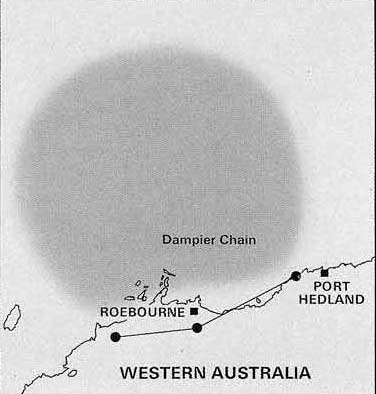 |
| Coverage of the Dampier chain. (From Decca Navigator News, October 1972) |
(Graphic courtesy Decca Navigator News April 1972)
 |
| Port Hedland lattice chart. Note the narrow channel, some 20 miles long that all ships had to use when navigating to the Port Hedland docking facilities. |
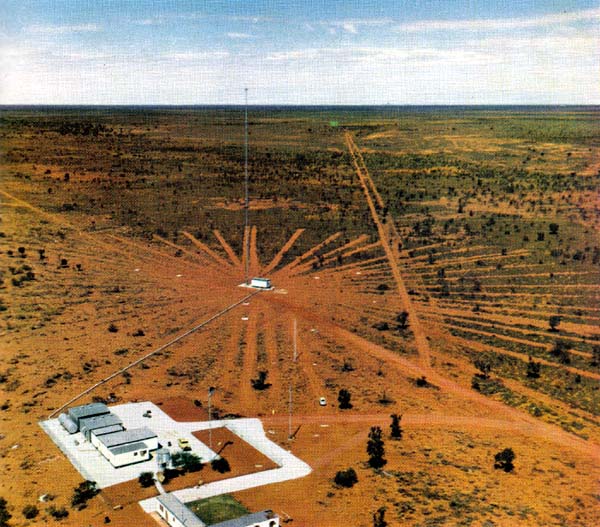 |
| A low level aerial view of the Port Hedland master station. |
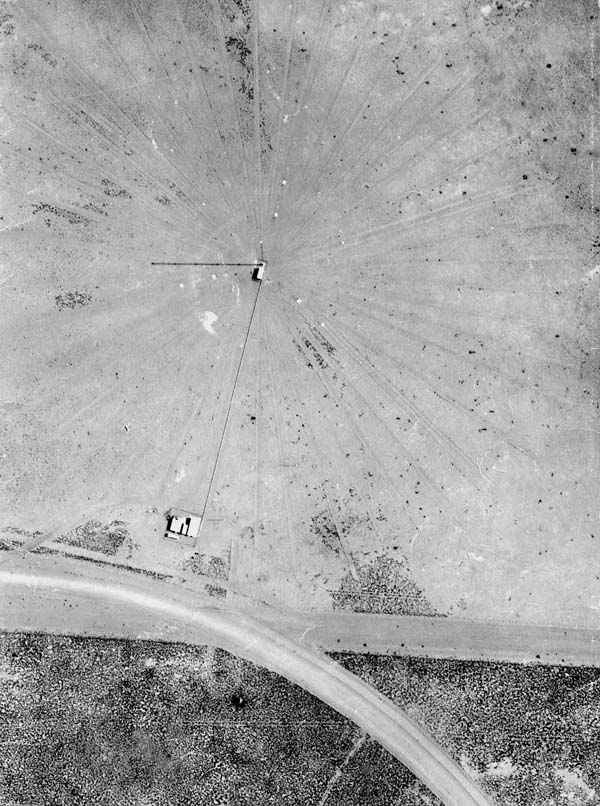 |
| A high level aerial view of the Port Hedland master station. |
 |
| Port Hedland monitor station showing UHF/VHF link antenna (left) and the emergency wind generator (right). |
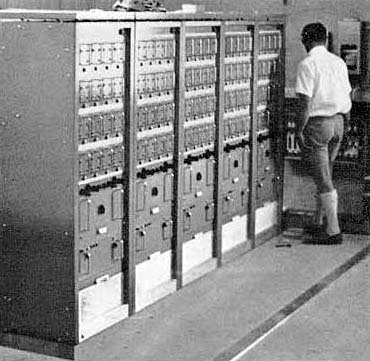 |
| A bank of transmitters at Port Hedland. |
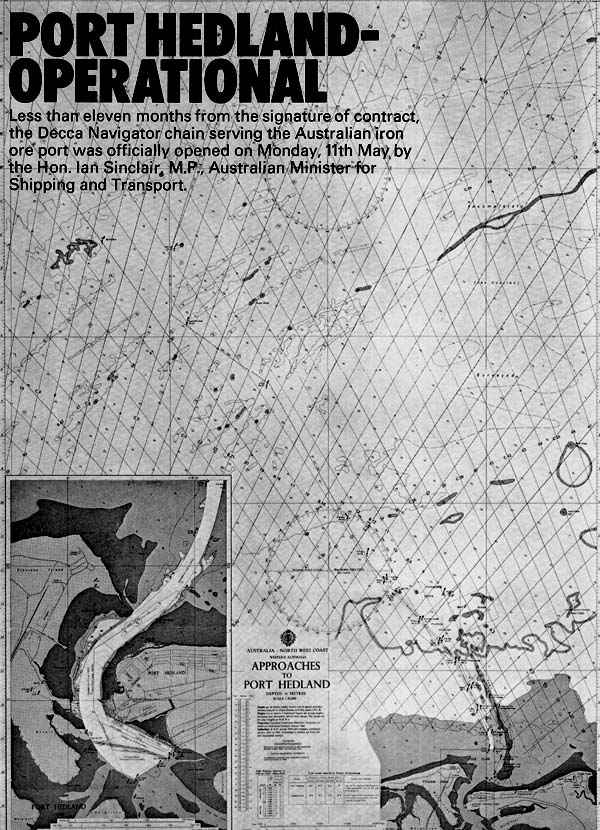 |
| This is a marine chart showing the approach to Port Hedland. |
| All images in this table from Decca Navigator News, August 1970 |
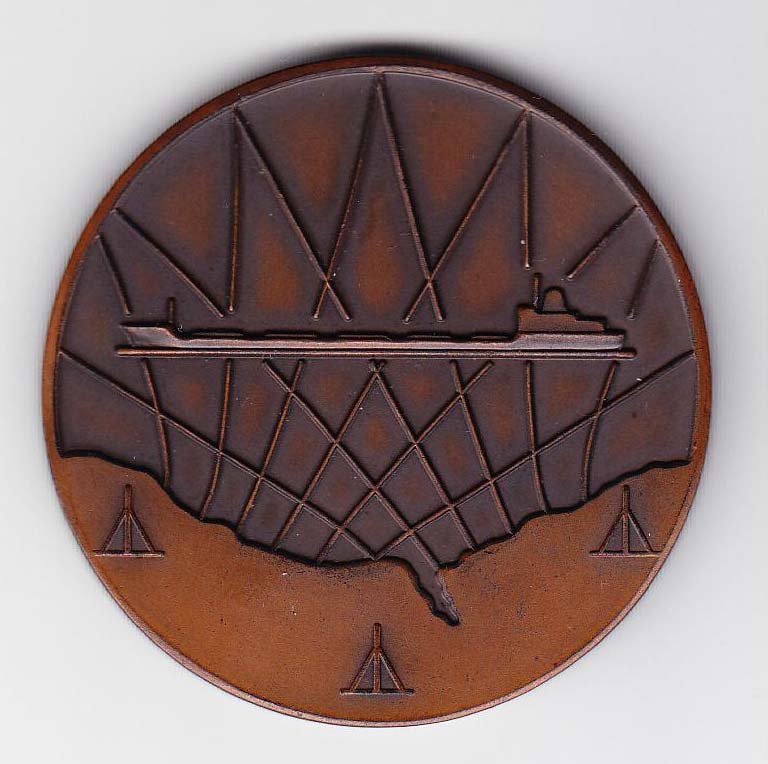 |
| Above (front) and below (back). This medallion was presented to station personnel of the Port Headland chain when it opened in May of 1970. (Images scanned by John B Fenn) |
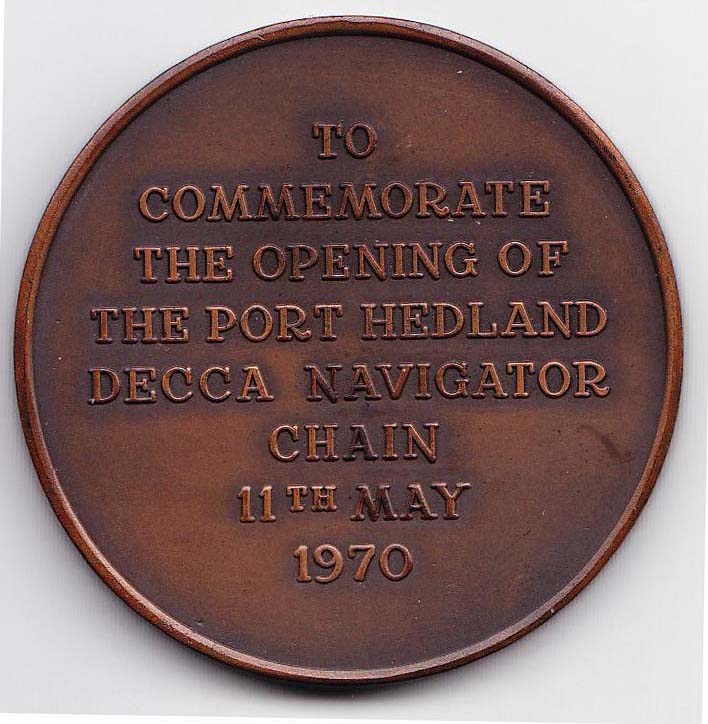 |
A CYCLONE HITS PORT HEDLAND
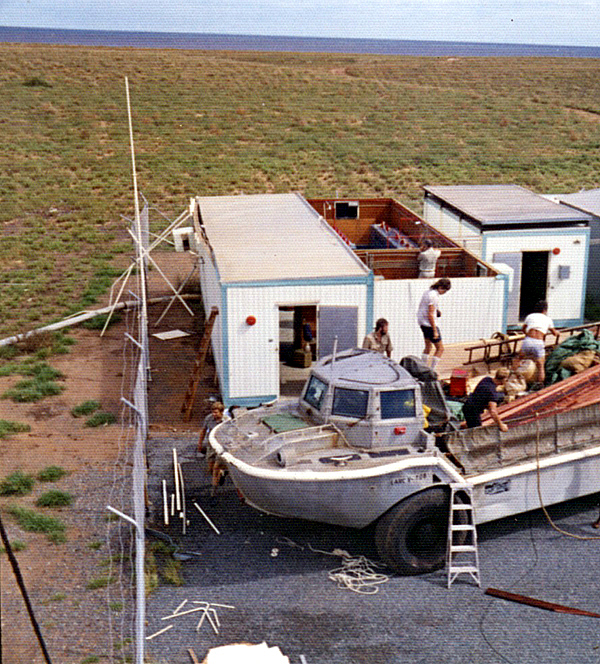 |
| On December 8/9 1975, Cyclone Joan ripped through Port Hedland and caused severe damage to the Green slave station. Half the roof was blown off and the coil house was damaged. Luckily, there were no injuries. To facilitate the station rebuild, the Australians anchored a 3,000 ton survey ship off-shore which the Decca crew used as a base of operations. They were shuttled back and forth by the "Duck" amphibious vehicle seen in this photo. |
 |
| With half the roof gone, the 1880 series equipment is exposed to the elements. Debris from the station was strewn some several hundred yards away. |
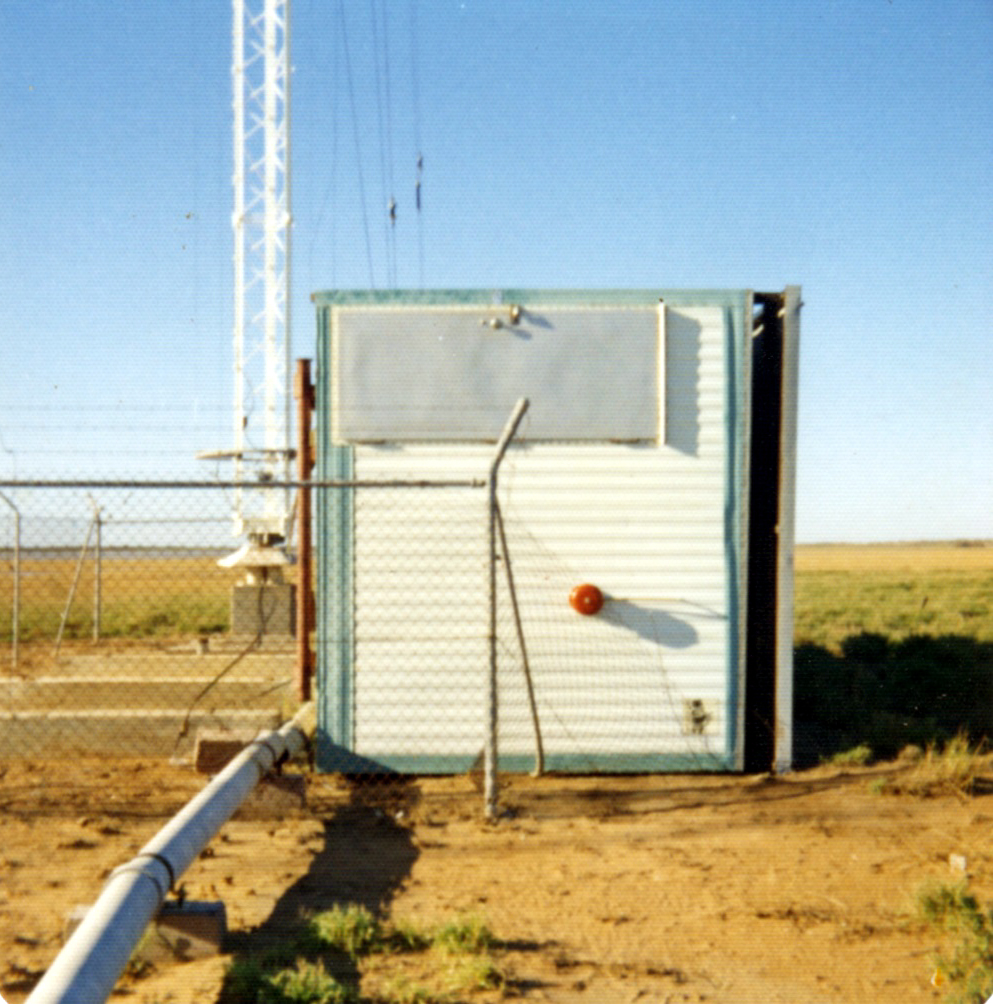 |
| The coil house was tipped on its side by the force of the wind and the coil was ruined. A new coil had to be shipped from the UK. There was no damage to the other stations in the Port Hedland or Dampier chains. |
| All photos in this table by Norman Morris |
The Dampier and Port Hedland chains were shut down somewhere in the 1987 to 1989 time frame. Steve Page, call sign VK6HV, immigrated from Los Angeles to Australia about 20 years ago (1995) and now resides about 35 kilometers from Decca Woodbrook, the former master station of the Dampier chain in the North West corner of Western Australia. He provides this account about the fate of the station."I have visited the Woodbrook site 4 to 5 times over the years and have taken numerous digital photos of the site. The site is still standing, so to speak and appears to have been simply abandoned after being taken out of service. The 300 foot tower, coil house and numerous building are still there. It appears the site was possibly in the hands of an indigenous corporation as a training facility and most recently, the Department of Justice (and ran by the local prison).
I first visited this site in 1999. Most everything was still in place, but in disrepair. The transmitters were still in place, there was a building with spare parts in it and when I went into a "repair shop/clean room" there was still an oscilloscope on the bench. I was as if they shut the power off and just walked out.
I last visited the site a couple two or three years ago (2012-2013) and the authority that uses the site had dug a few ditches and buried whatever they could unbolt from the floor and whatever was not secured. Yes, this included the transmitters, back up generator, spare parts etc. etc. On the day I was there, they had not back filled the ditches yet, so I took some photos. It was kind of sad".
WOODBROOK BUILDING and PROPERTY PHOTOS
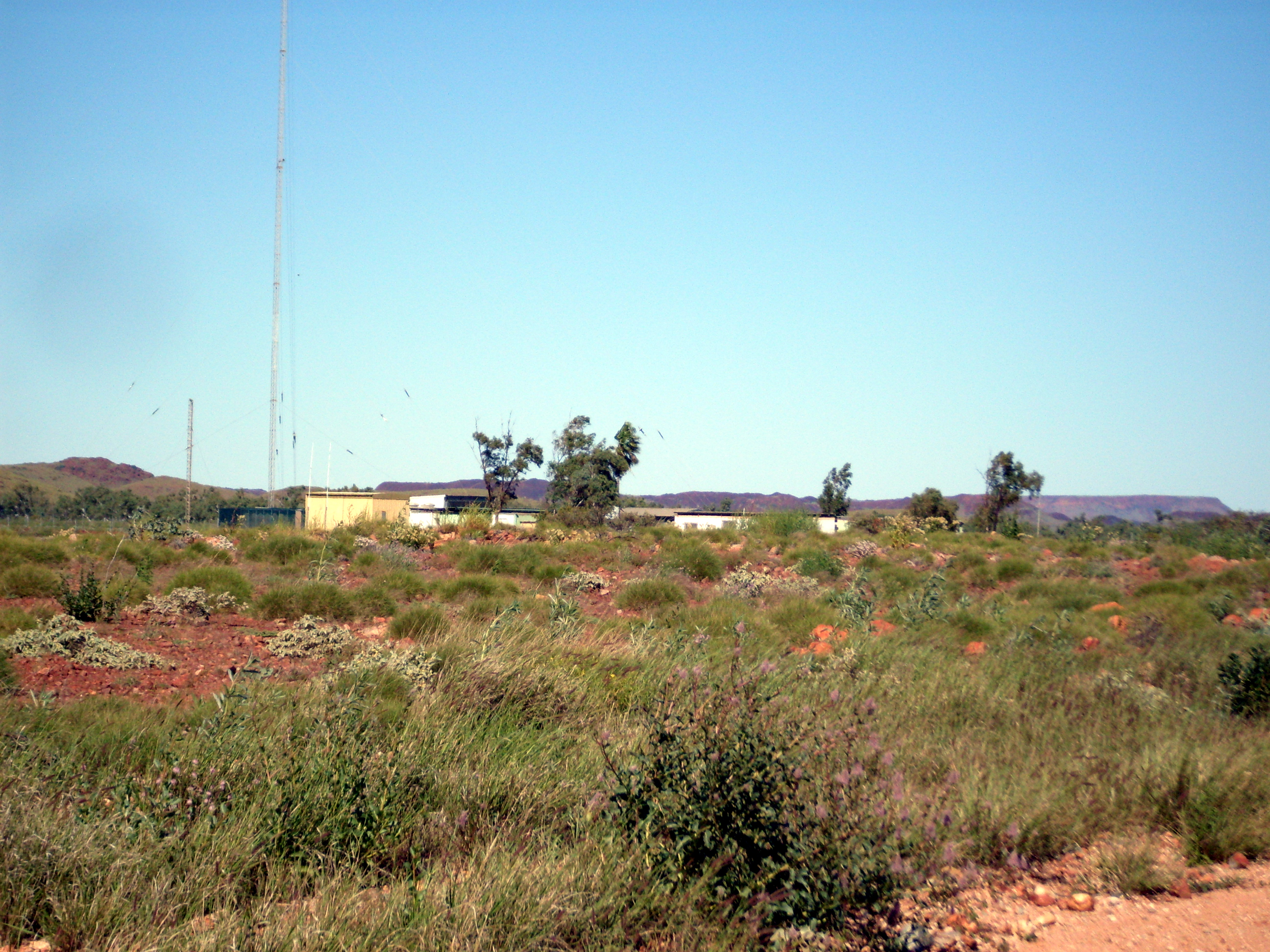 |
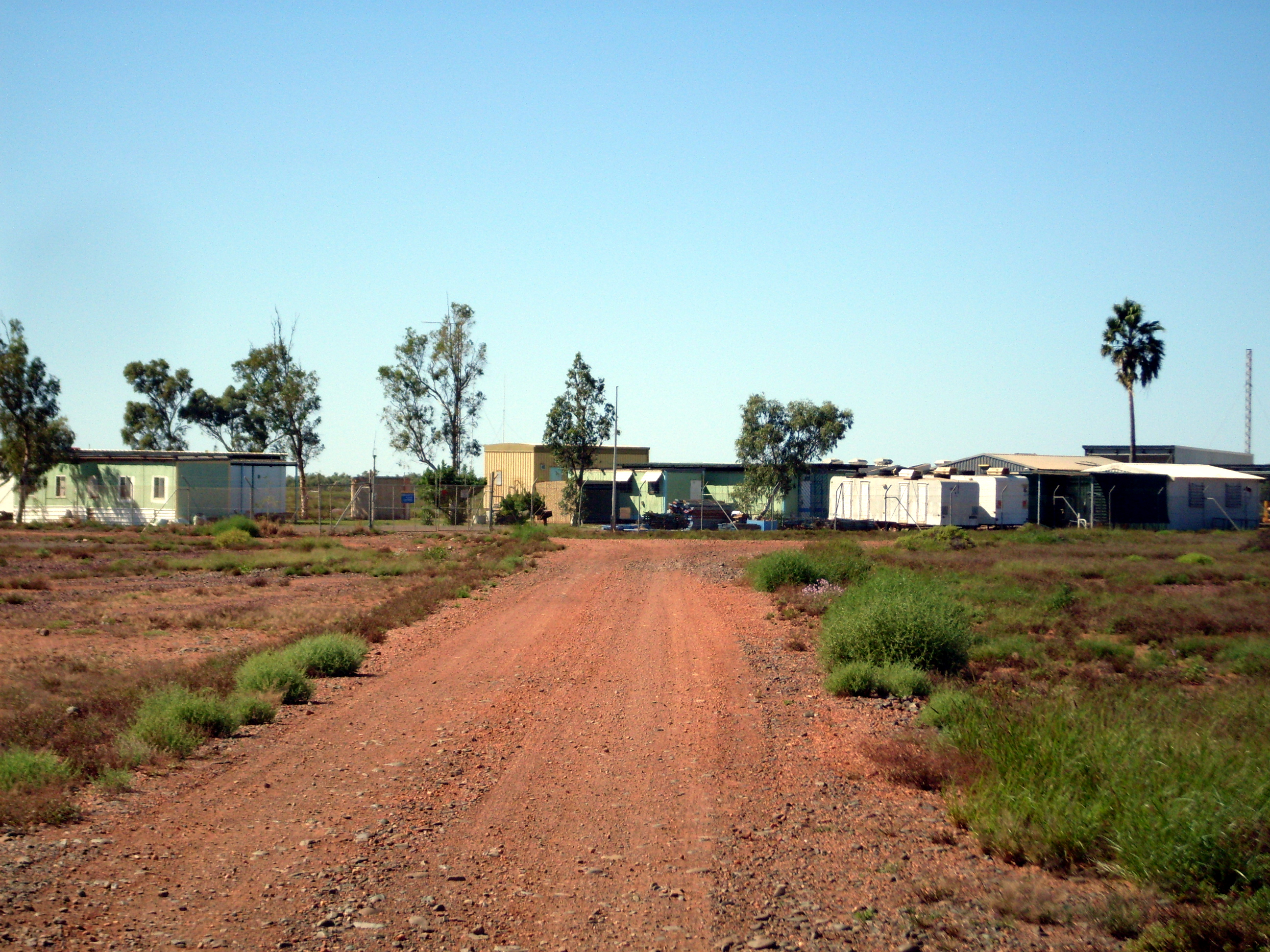 |
 |
| The above three photos show the Woodbrook station as it appeared in 2011: |
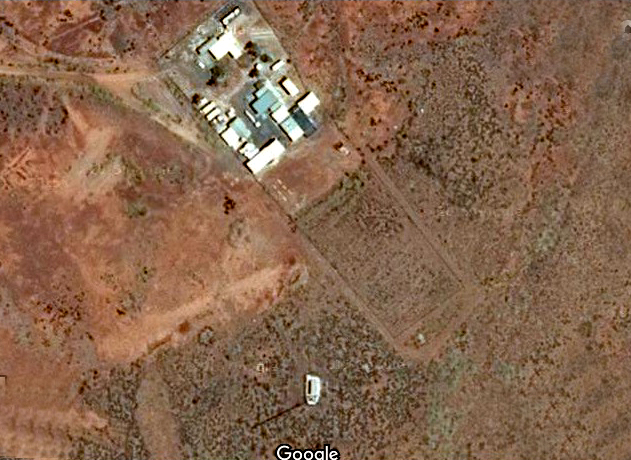 |
| A satellite view of the Woodbrook site as it appears in a 2015 satellite view. In the 11 o'clock position, some transportable buildings have been added to the original complement when Decca was still active. The coil house and the shadow of the tower can be seen at the 6 o'clock position. Pointing towards 4 o'clock is a rectangular fenced in area. Currently, this is a vegetable garden and it needs to be fenced in to keep the kangaroos out. Otherwise, they will come in at night and eat everything in sight. It is believed that the garden is used to provide agricultural training. (Image courtesy Google Maps) |
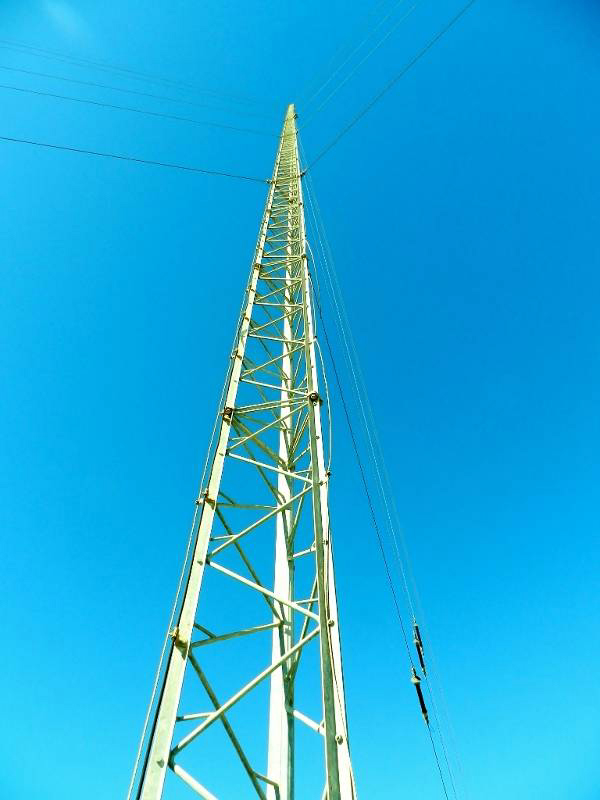 |
| Close up of the the tower at Woodbrook. |
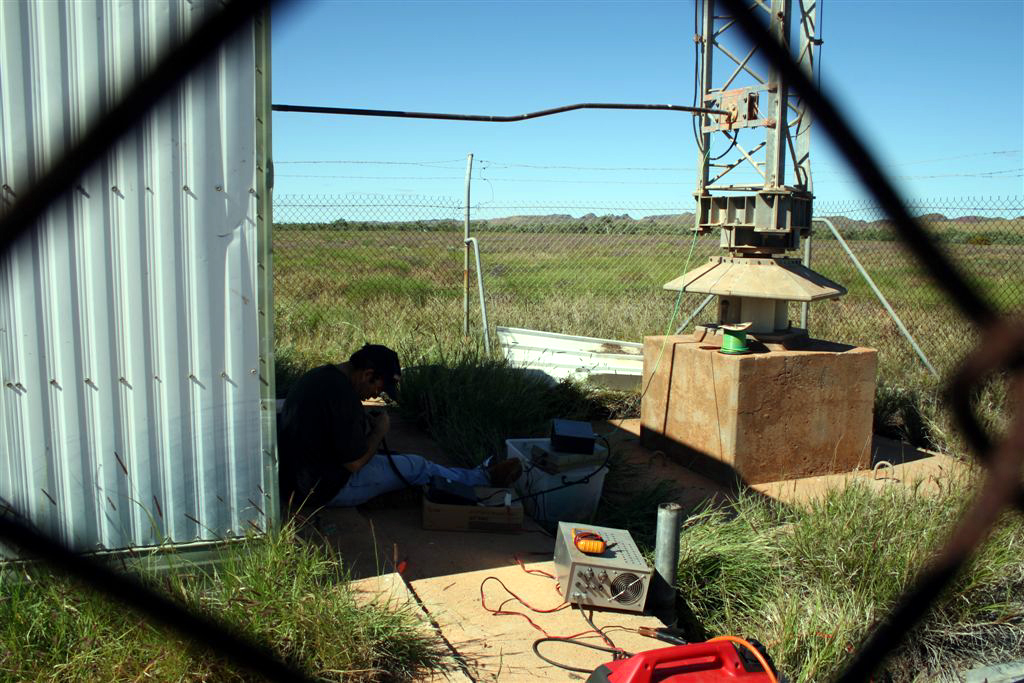 |
| Tower support pad. |
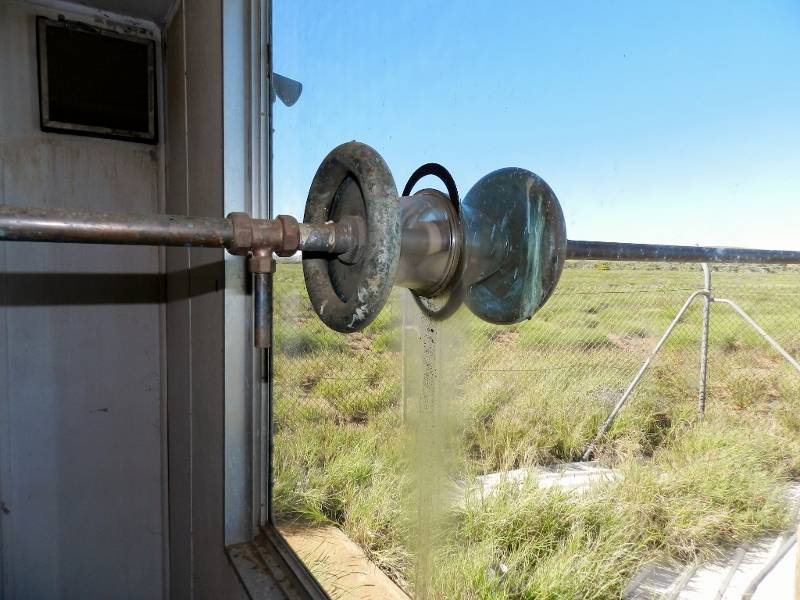 |
| Detailed view of the feedthrough insulator in the coil house. |
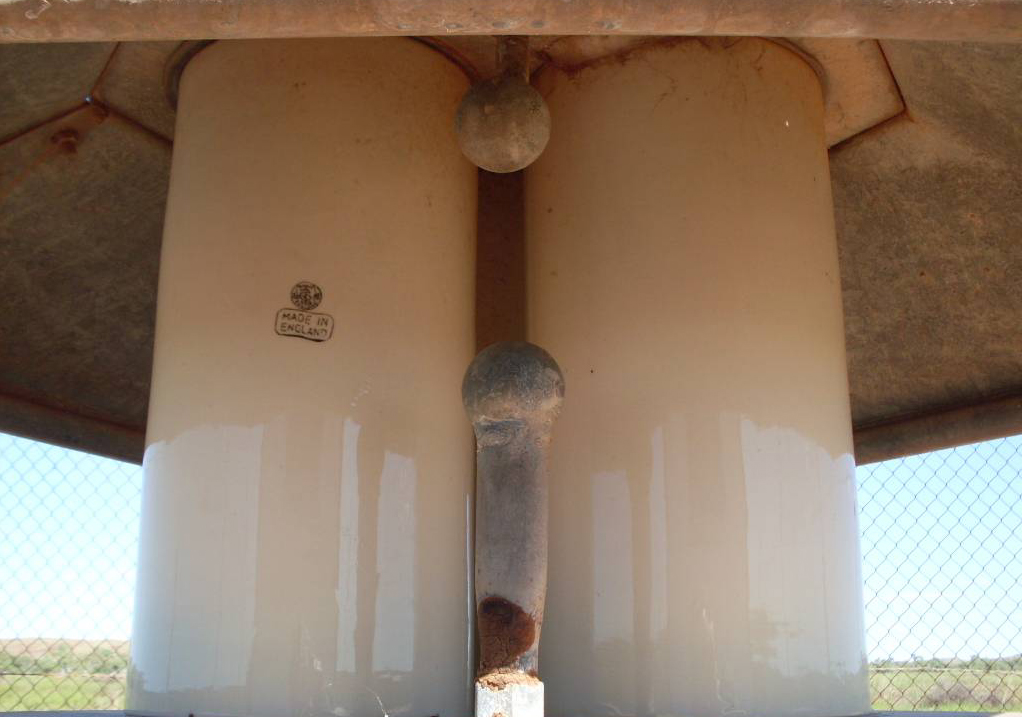 |
| These ceramic insulators support the entire weight of the tower. |
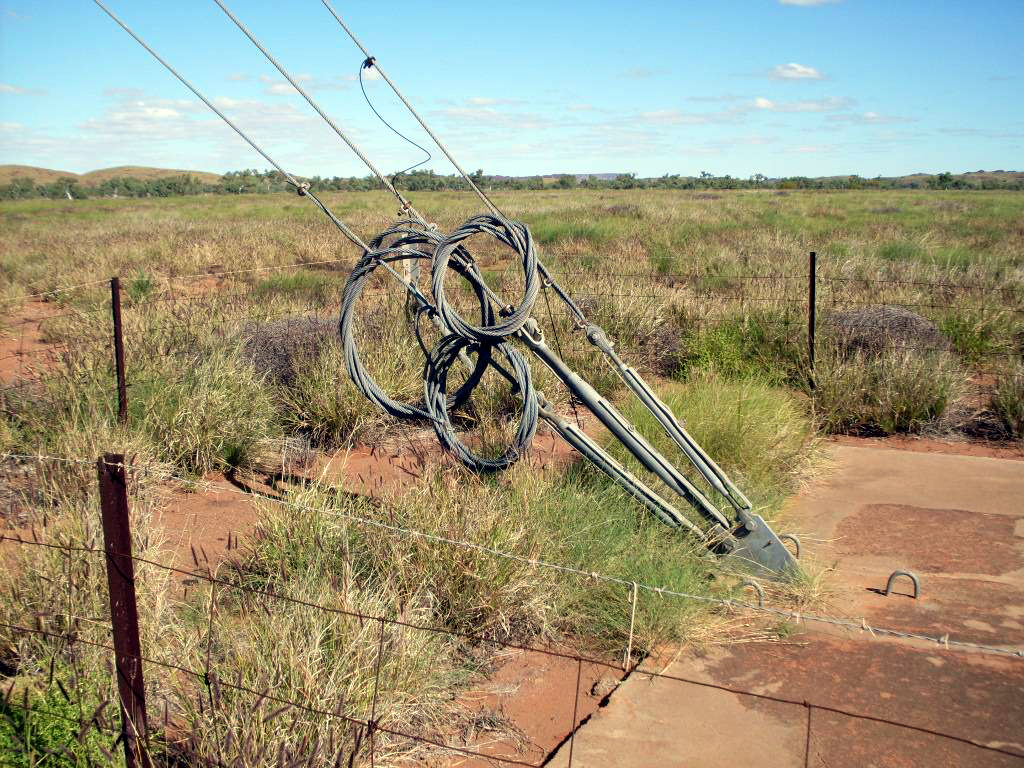 |
| Guy wire details and anchor. This anchor is one of several. |
| Unless otherwise noted, all photos in this table by Steve Page, VK6HV |
WOODBROOK EQUIPMENT PHOTOS (AS FOUND IN 2011)
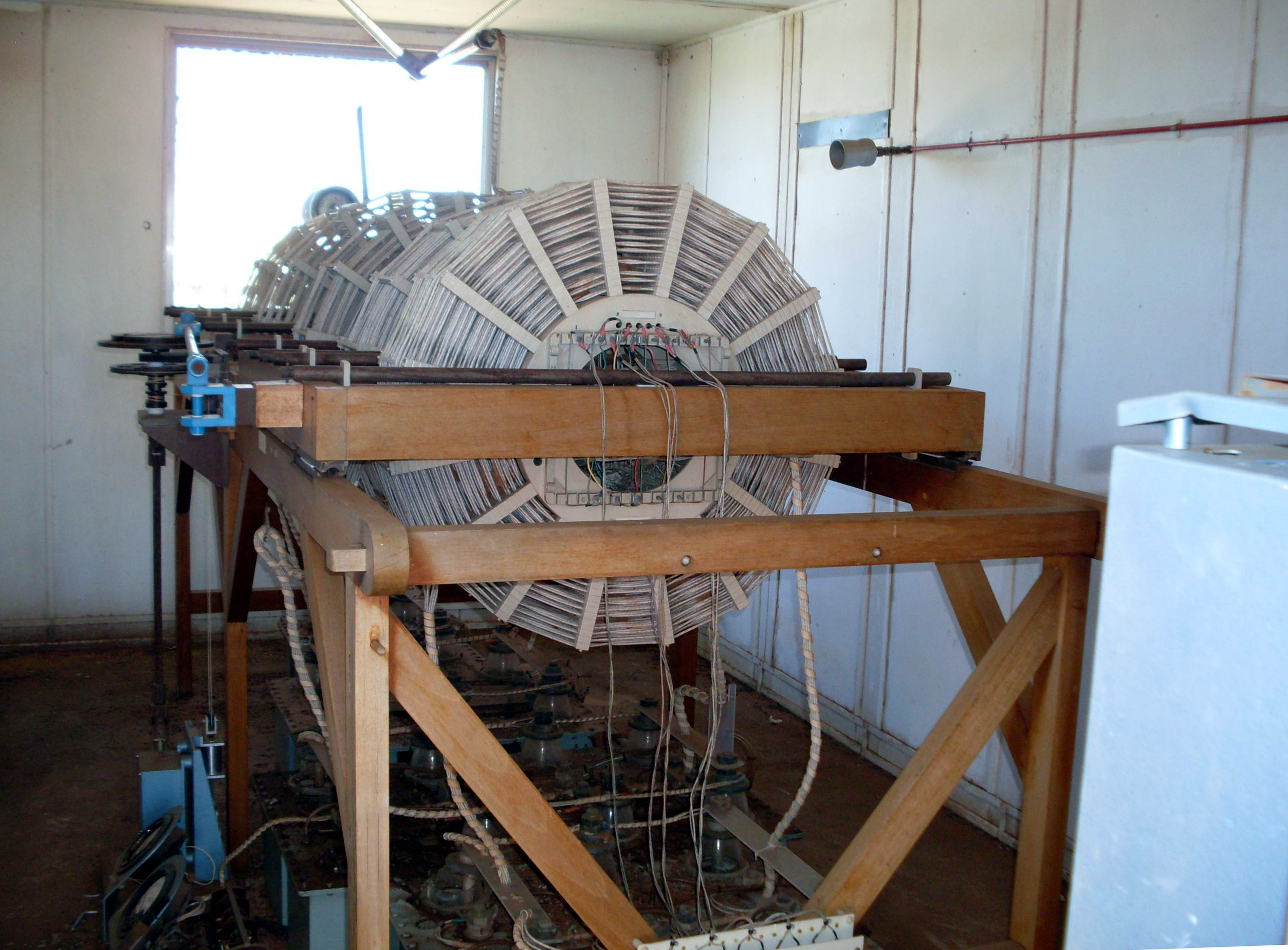 |
| Coil house view. The capacitors which resonate the coil to the desired frequency are mounted directly below the coil. |
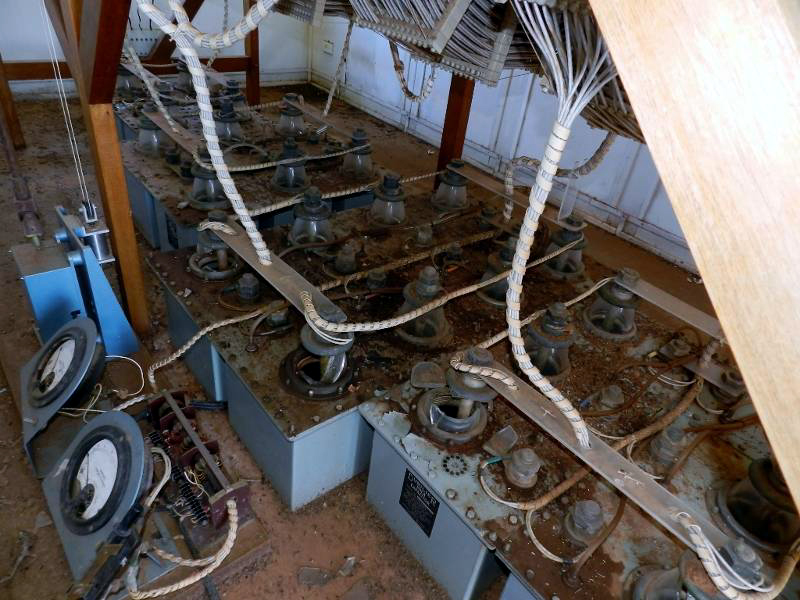 |
| This is all that remains of the capacitor bank at the Woodbrook station after it was vandalized. Some of the glass insulators atop the capacitors have been broken. The capacitor bank was located directly below the coil in the coil house. The purpose of these capacitors were to resonate the tuned circuits in the output stage. Note the antenna ammeter and thermal meter in the lower left hand corner. |
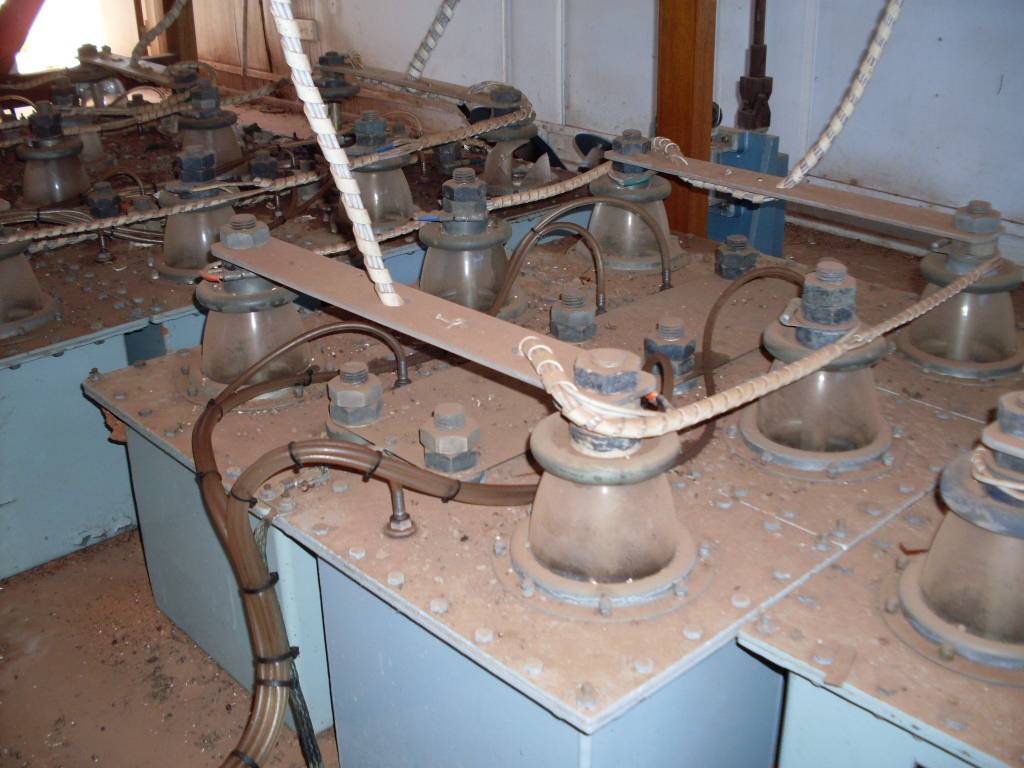 |
| Closeup view of the capacitors showing the glass insulators. One of the capacitors was marked as .005 uf @6.5 kv. 85 to 127 kHz. 21.8 amps @70 KHz. |
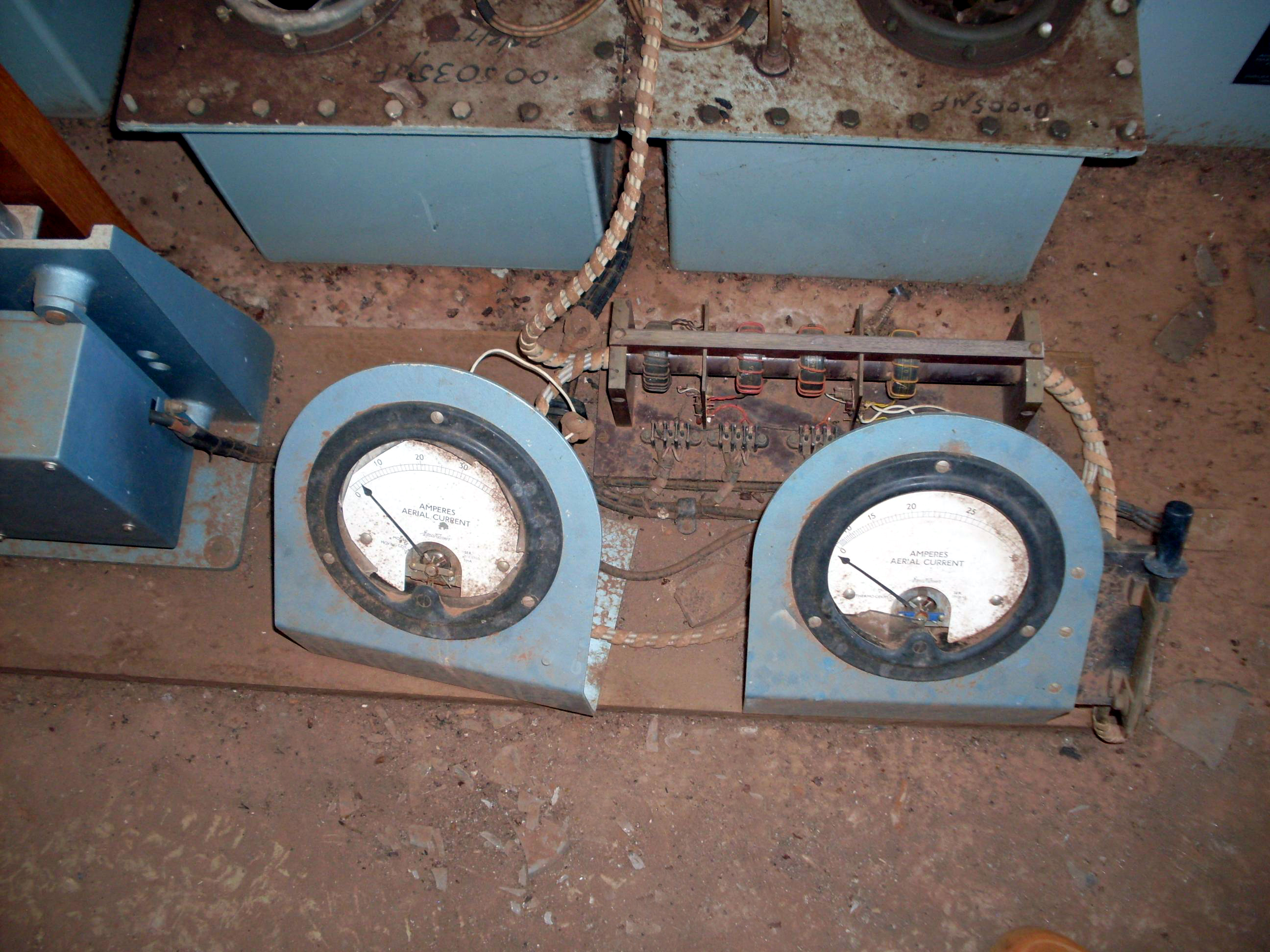 |
| Closeup of the meter panel. RF ammeter is on the left. An RF
thermal meter on the right side was connected to the ground side tail of
the C coil. To take a reading, the knife switch was opened. Next to that
is the DC ammeter that was fed from the phase loop transformer that sits
behind it with a single turn of the C coil tail going through it. Output
from this transformer was also sent back to the phase control racks to
keep the station stable.
The blue box to the left of the ammeters is the ATAM drive motor for
keeping the coils tuned. It is a DC motor whose polarity is switched to
provide a rotation in either direction to the C coil drive shaft. The motor
is controlled by the main ATAM (Antenna Tuning and Matching), unit which
is
|
 |
| Antenna feeder matching unit type 1965 with motor drive. This was the later version of a Matching Unit that was driven from the ATAM. |
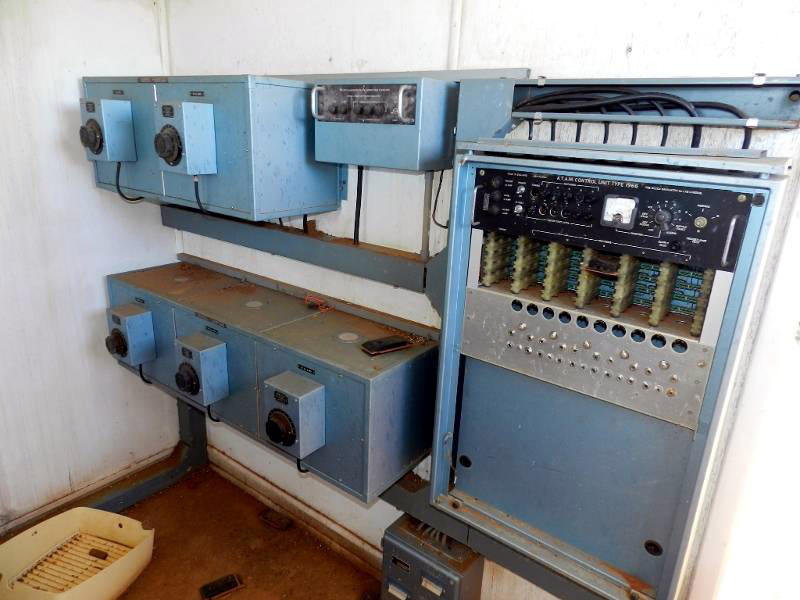 |
| This view of the coil house inside wall shows five matching units and the type 1966 ATAM. |
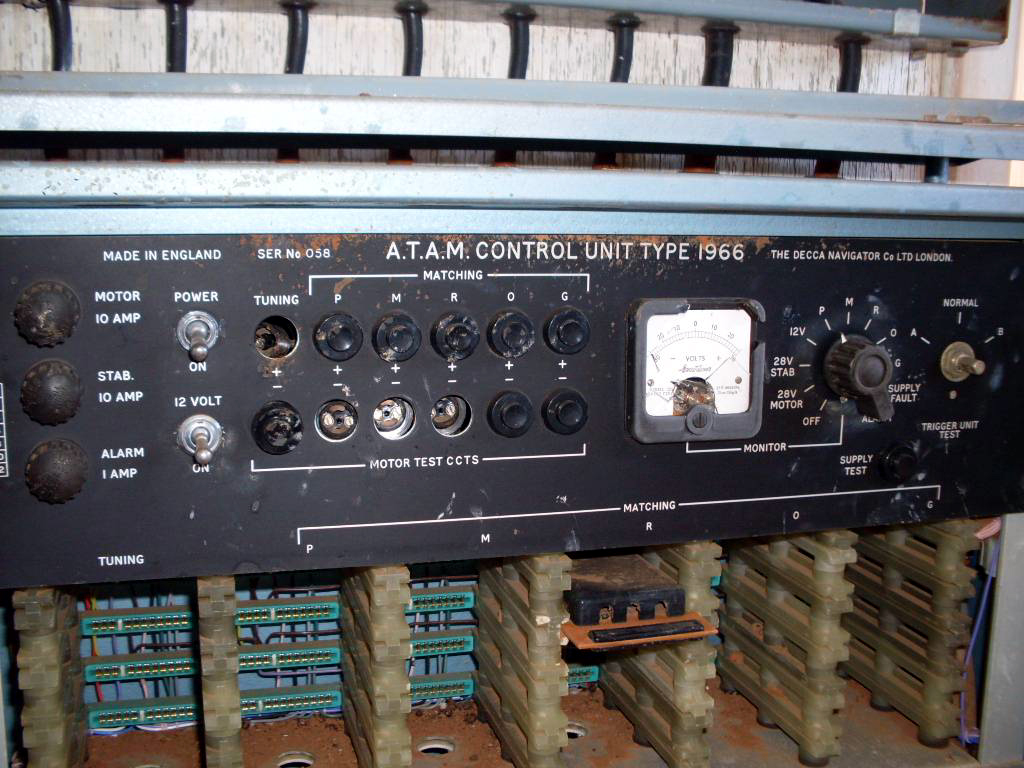 |
| Closeup of the ATAM control panel showing the drive motor fuses, control card slots and display selector. |
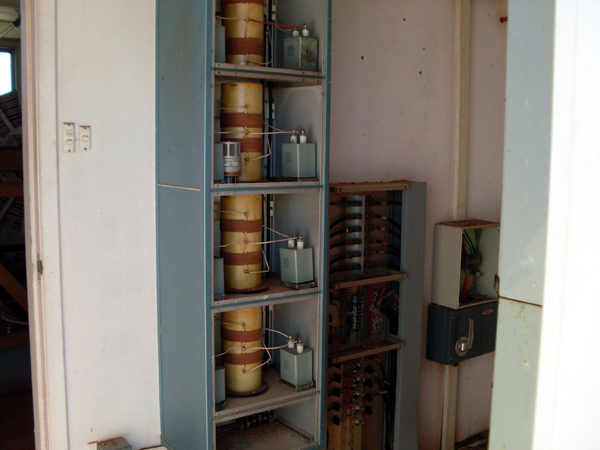 |
| The Line Compensating Unit is mounted adjacent to the coil house entry door and connects between the incoming transmitter feeder cables and the adjacent Matching Units. |
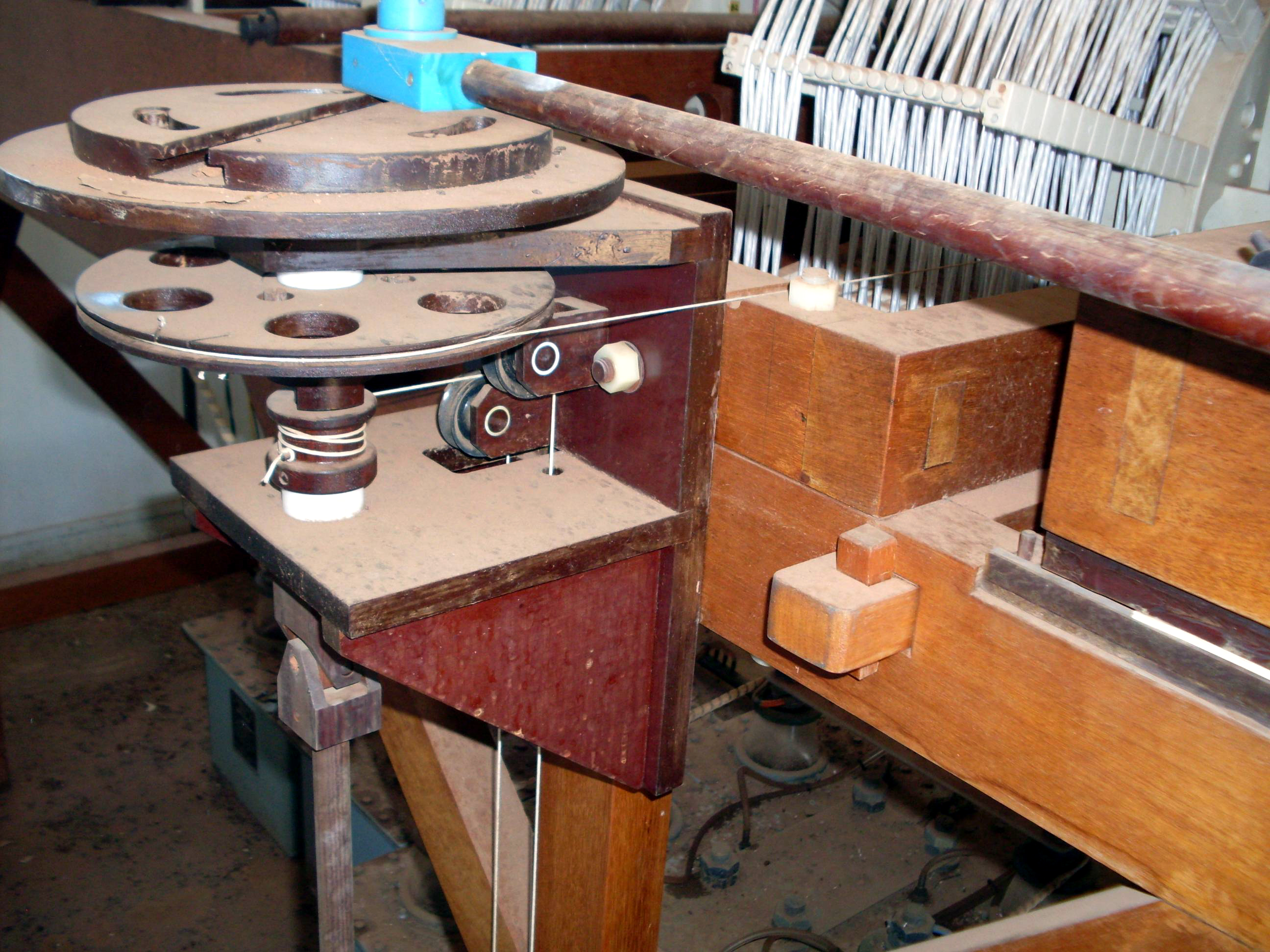 |
| This view shows the C coil tuning rotor drive with the crank link to the D-E coil carriage. The shaft drive and link to the floor mounted ATAM tuning motor can also be seen. All this is standard for the type 1880 series station equipment. |
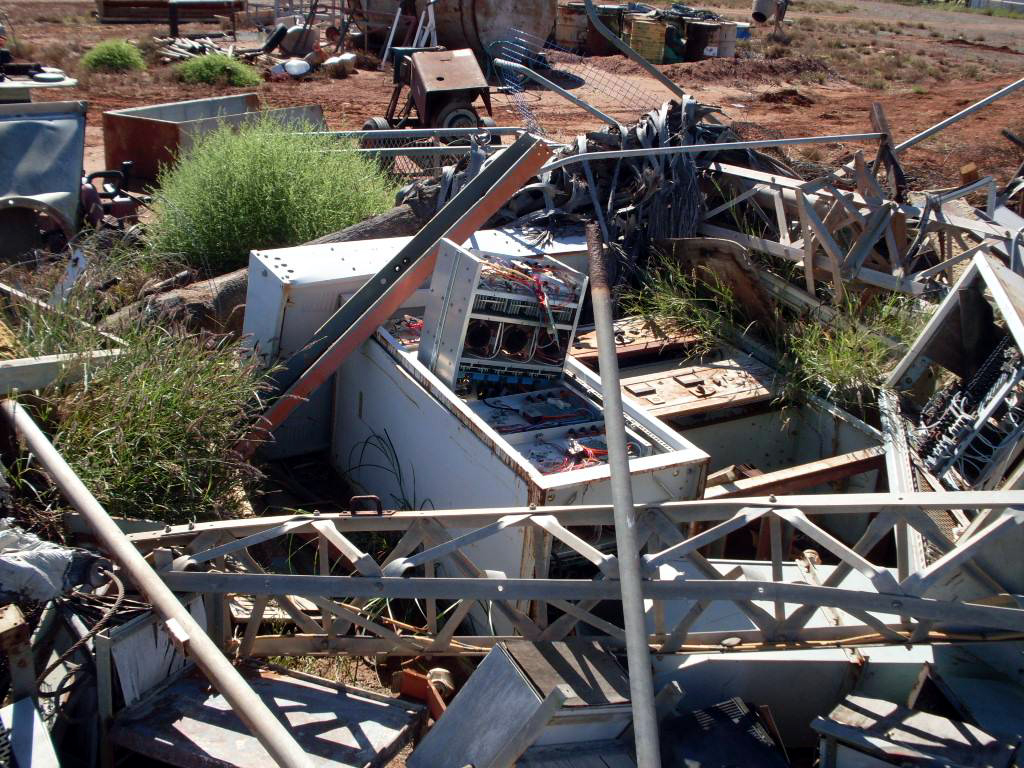 |
| The equipment carnage photo speaks for itself. Some time in the 2000's , a few ditches were dug and any equipment that could be unbolted from the station floor and whatever was not secured was dumped or buried here. |
| All photos in this table by Steve Page VK6HV |
DE GREY RIVER STATION (Port Hedland Green)
 |
| This is the De Grey River site at 20°21'S 118°59'E. In the very centre of the picture there appears to be the shadow that would be cast from a Decca transmitting tower. It is believed that this property may be in the hands of the Department of Justice, so there is no easy way to obtain site access to see what equipment may have been abandoned there. Perhaps this site is now being used for the same purpose as the Woodbrook site. (Image courtesy Google Maps) |
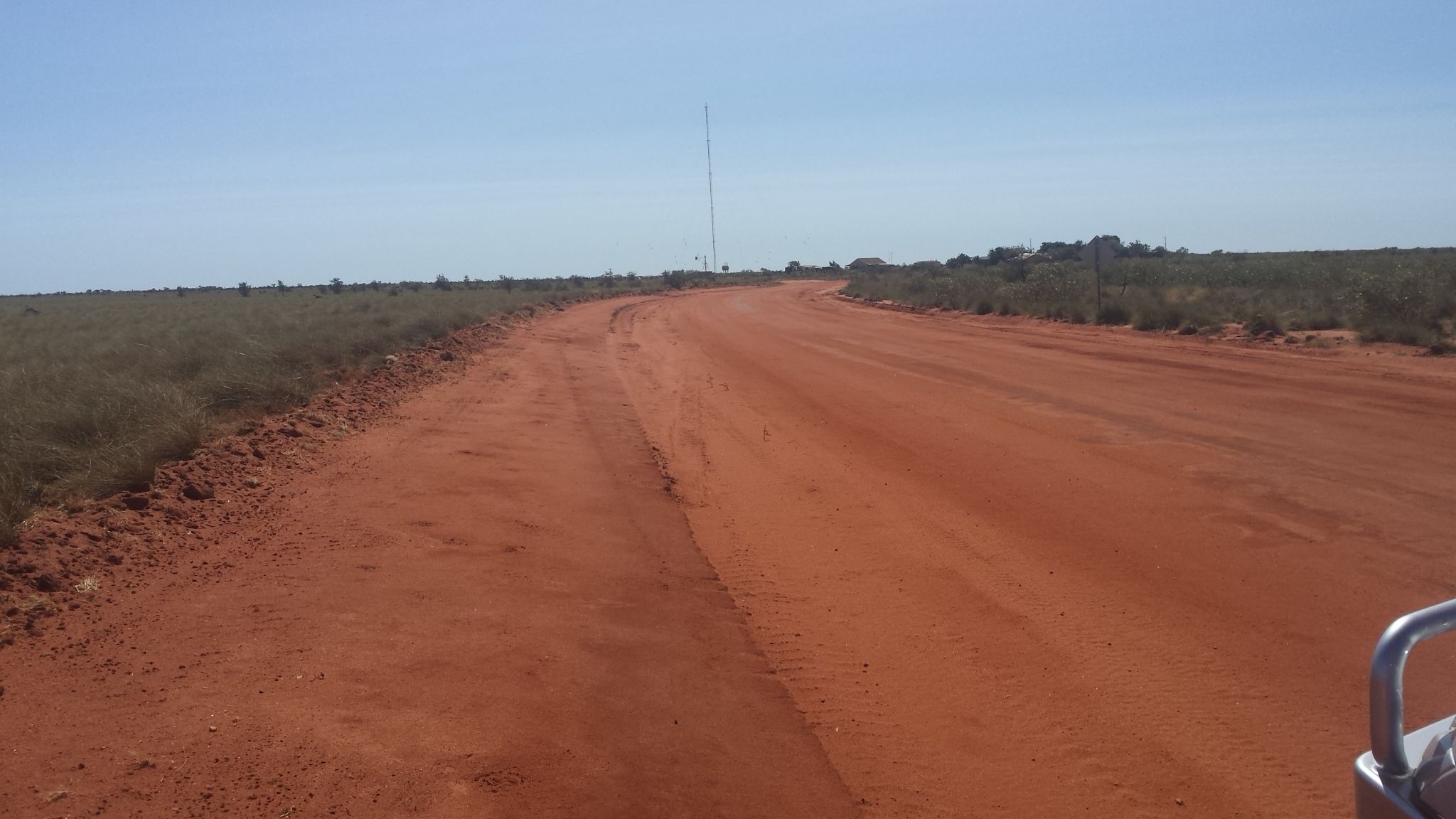 |
| This is the dirt road leading up to the transmitter site. The tower can be seen in the distance. |
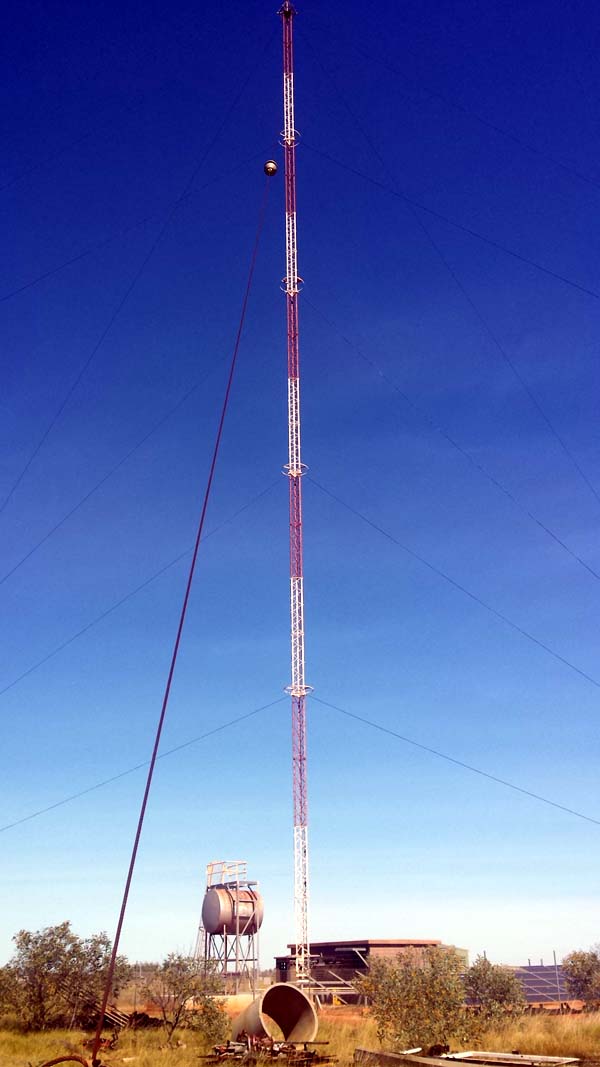 |
| The tower is still standing as of July 2017. It is 240 feet high. |
 |
| Tower base. |
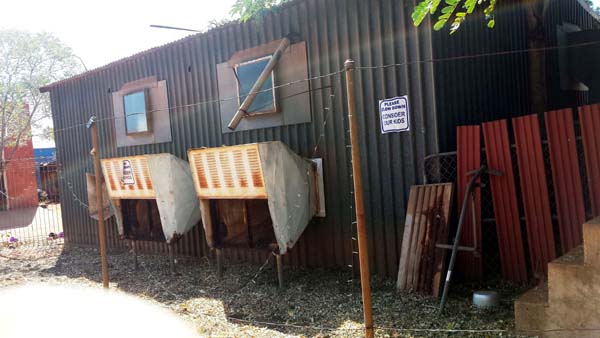 |
| Transmitter shed. |
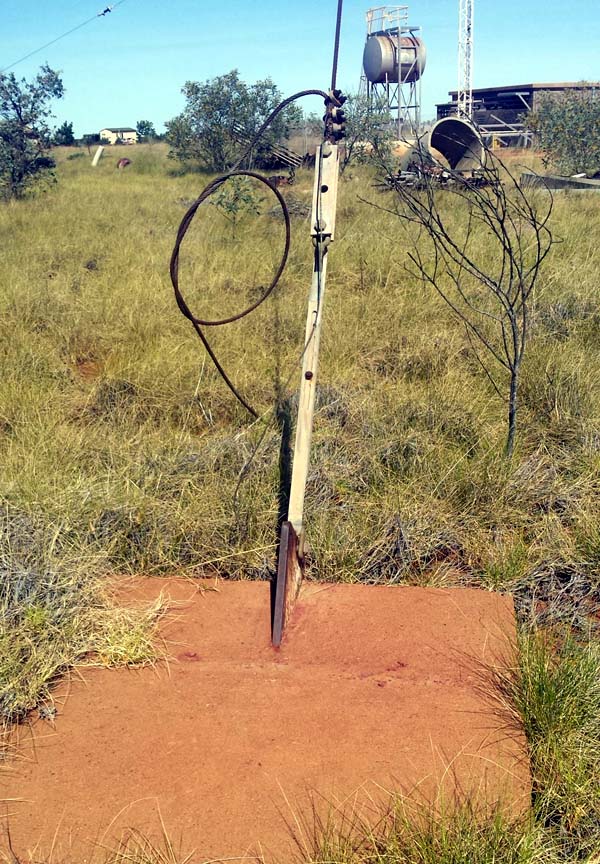 |
| Single guy wire arrangement. |
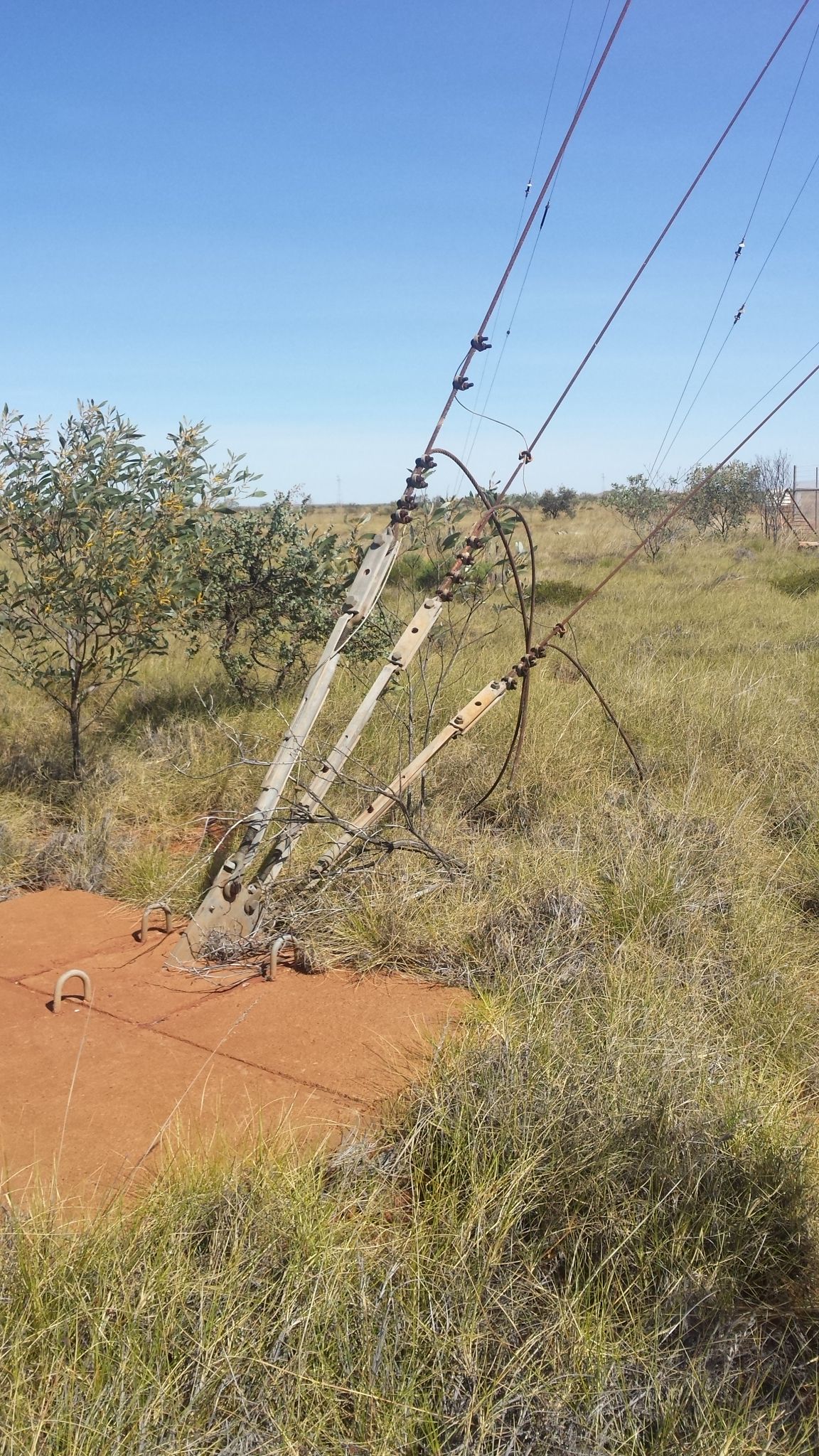 |
| Multiple guy wire arrangement. |
| All photos in this table by Steve Page, VK6HV. |
TURNER RIVER STATION (Port Hedland Master)
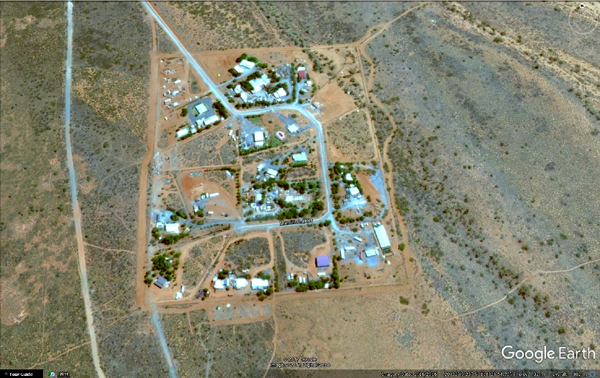 |
| The former Turner River site as it appeared in July 2017. It is located about 15 kilometers south of Port Hedland. (Image courtesy Google Earth) |
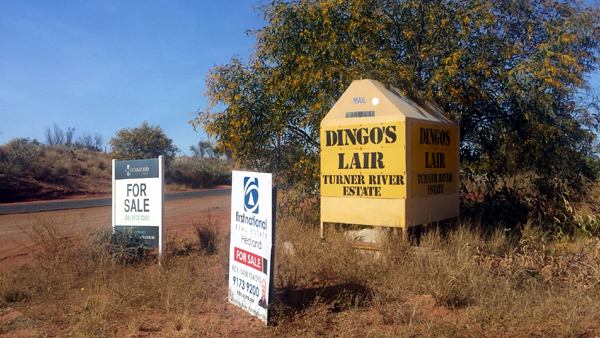 |
| One of the approaches to the Turner River settlement. This is the junction of the Turner River Estate Road and the Great Northern Highway where the two connect. (Photo by Steve Page VK6HV) |
Steve Page VK6HV and Jono Bucktrout VK6DF wrote this 2018 article about the Decca chains in Australia.
Contributors and Credits:1) John Fenn <johnbfenn(at)aol.com>
2) Norman Morris <bronzefire103(at)yahoo.co.uk>
3) Steve Page VK6HV <vk6hv(at)westnet.com.au>
4) David Jones <dsjjones(at)bellsouth.net>
Oct 26//2019